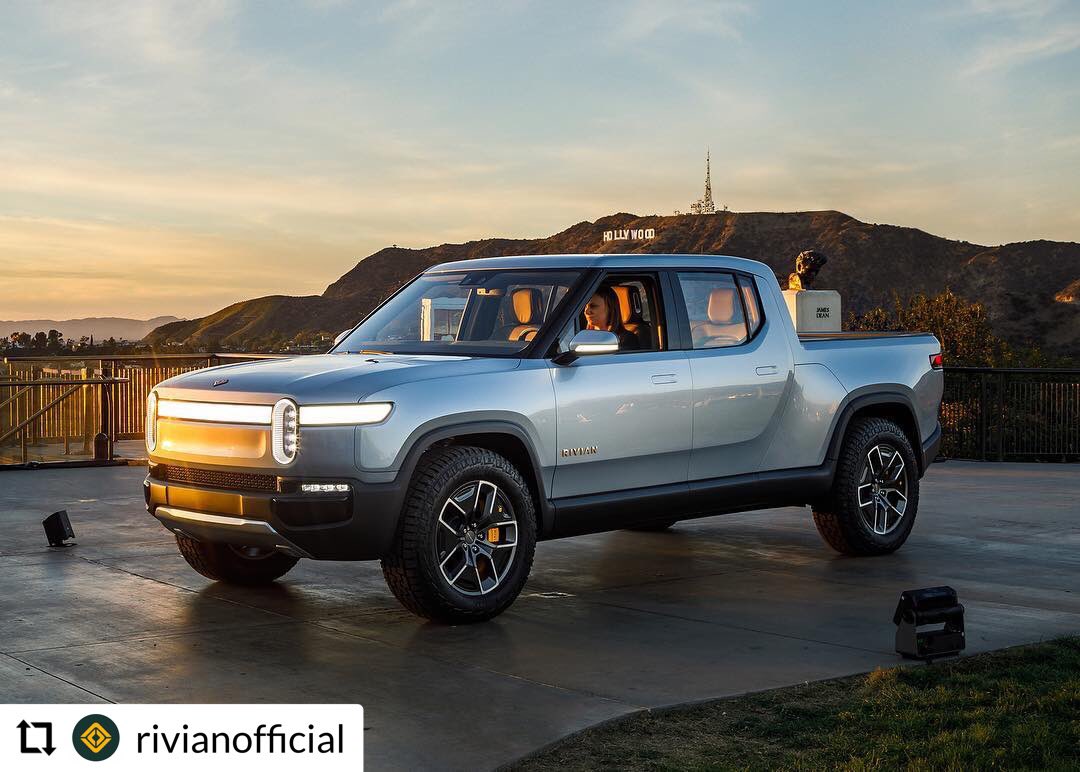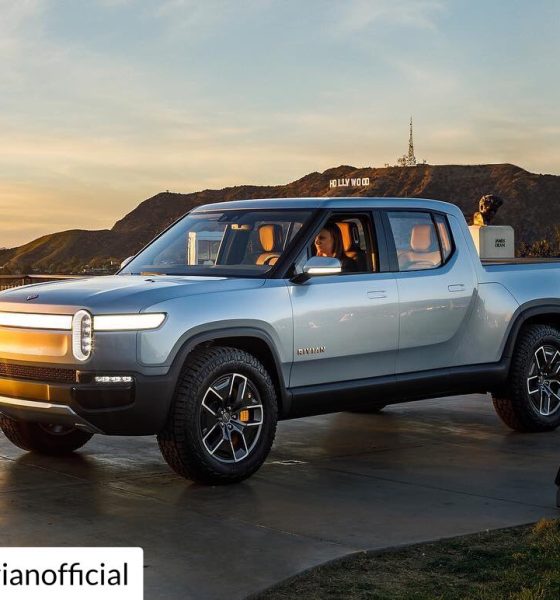

News
Rivian CEO talks R1T and R1S battery packs, drivetrains and suspension
In a recent interview with Chuck Tannert of Forbes, Rivian CEO RJ Scaringe discussed a number of details related to his electric car company’s first two vehicles — the R1T pickup truck and the R1S SUV. While speaking with the journalist, Scaringe talked about the Rivian skateboard, which contains the vehicles’ batteries, drivetrain, and suspension.
Scaringe noted in his interview that he has always been fascinated with “things that move,” to the point where he helped a neighbor build a Porsche 356s in a garage at a young age. This fascination for vehicles carried over all the way through Scaringe’s doctorate at MIT’s prestigious Sloan Automotive Lab, and to his tenure as Rivian’s founder and CEO. Scaringe even admitted that if push comes to shove, he would rather be working on a lab, pushing Rivian’s skateboard platform further.

Similar to other electric vehicles like Tesla Model S and the Porsche Taycan, the Rivian R1T and the R1S utilize a skateboard design. This means that all the vehicles’ mechanical components, including their battery, drivetrain and suspension are all contained in one place. Suspension-wise, Rivian uses a double wishbone system on the front and a multi-link setup on the rear of the R1T and the R1S. These offer dynamic roll and adaptive dampers, along with air suspension, allowing the pickup truck and SUV to traverse rough terrain. The pickup truck and SUV’s drivetrain is also notable, as each wheel is powered by a 147-kW all-electric motor.
Rivian’s true, clever innovations are highlighted on the company’s battery pack. Rivian utilizes cylindrical 2170 cells to power its vehicles. These cells are grouped into modules, which are then stacked on top of each other. Each Rivian module holds 864 cells — 432 on the bottom layer and an equal number on the upper layer. Between the cells is a thin aluminum plate with liquid coolant, helping the batteries prevent overheating. This system is so far unique to Rivian.
Being luxury adventure vehicles, Rivian’s battery packs — regardless of their 105 kWh, 135 kWh, and 180 kWh configuration — are protected by a carbon fiber composite shell. Battery packs are watertight as well, and a “ballistic shield” covers the entire underbody of the vehicles. This allows both the R1T and the R1S to be capable of handling extreme levels of off-road punishment.
Rivian surprised the auto and electric car industry when it left stealth mode and revealed two production-ready vehicles last year. So far, the company aims to produce around 20,000 units of the R1T and R1S on the vehicles’ first year of production. As for the company’s future, Scaringe noted that he would let Rivian’s results prove his point. “I tend to be quiet to outsiders about what we’re doing. Let the results speak for themselves,” he said.

News
Tesla FSD fleet is nearing 7 billion total miles, including 2.5 billion city miles
As can be seen on Tesla’s official FSD webpage, vehicles equipped with the system have now navigated over 6.99 billion miles.

Tesla’s Full Self-Driving (Supervised) fleet is closing in on almost 7 billion total miles driven, as per data posted by the company on its official FSD webpage.
These figures hint at the massive scale of data fueling Tesla’s rapid FSD improvements, which have been quite notable as of late.
FSD mileage milestones
As can be seen on Tesla’s official FSD webpage, vehicles equipped with the system have now navigated over 6.99 billion miles. Tesla owner and avid FSD tester Whole Mars Catalog also shared a screenshot indicating that from the nearly 7 billion miles traveled by the FSD fleet, more than 2.5 billion miles were driven inside cities.
City miles are particularly valuable for complex urban scenarios like unprotected turns, pedestrian interactions, and traffic lights. This is also the difference-maker for FSD, as only complex solutions, such as Waymo’s self-driving taxis, operate similarly on inner-city streets. And even then, incidents such as the San Francisco blackouts have proven challenging for sensor-rich vehicles like Waymos.
Tesla’s data edge
Tesla has a number of advantages in the autonomous vehicle sector, one of which is the size of its fleet and the number of vehicles training FSD on real-world roads. Tesla’s nearly 7 billion FSD miles then allow the company to roll out updates that make its vehicles behave like they are being driven by experienced drivers, even if they are operating on their own.
So notable are Tesla’s improvements to FSD that NVIDIA Director of Robotics Jim Fan, after experiencing FSD v14, noted that the system is the first AI that passes what he described as a “Physical Turing Test.”
“Despite knowing exactly how robot learning works, I still find it magical watching the steering wheel turn by itself. First it feels surreal, next it becomes routine. Then, like the smartphone, taking it away actively hurts. This is how humanity gets rewired and glued to god-like technologies,” Fan wrote in a post on X.
News
Tesla starts showing how FSD will change lives in Europe
Local officials tested the system on narrow country roads and were impressed by FSD’s smooth, human-like driving, with some calling the service a game-changer for everyday life in areas that are far from urban centers.

Tesla has launched Europe’s first public shuttle service using Full Self-Driving (Supervised) in the rural Eifelkreis Bitburg-Prüm region of Germany, demonstrating how the technology can restore independence and mobility for people who struggle with limited transport options.
Local officials tested the system on narrow country roads and were impressed by FSD’s smooth, human-like driving, with some calling the service a game-changer for everyday life in areas that are far from urban centers.
Officials see real impact on rural residents
Arzfeld Mayor Johannes Kuhl and District Administrator Andreas Kruppert personally tested the Tesla shuttle service. This allowed them to see just how well FSD navigated winding lanes and rural roads confidently. Kruppert said, “Autonomous driving sounds like science fiction to many, but we simply see here that it works totally well in rural regions too.” Kuhl, for his part, also noted that FSD “feels like a very experienced driver.”
The pilot complements the area’s “Citizen Bus” program, which provides on-demand rides for elderly residents who can no longer drive themselves. Tesla Europe shared a video of a demonstration of the service, highlighting how FSD gives people their freedom back, even in places where public transport is not as prevalent.
What the Ministry for Economic Affairs and Transport says
Rhineland-Palatinate’s Minister Daniela Schmitt supported the project, praising the collaboration that made this “first of its kind in Europe” possible. As per the ministry, the rural rollout for the service shows FSD’s potential beyond major cities, and it delivers tangible benefits like grocery runs, doctor visits, and social connections for isolated residents.
“Reliable and flexible mobility is especially vital in rural areas. With the launch of a shuttle service using self-driving vehicles (FSD supervised) by Tesla in the Eifelkreis Bitburg-Prüm, an innovative pilot project is now getting underway that complements local community bus services. It is the first project of its kind in Europe.
“The result is a real gain for rural mobility: greater accessibility, more flexibility and tangible benefits for everyday life. A strong signal for innovation, cooperation and future-oriented mobility beyond urban centers,” the ministry wrote in a LinkedIn post.
News
Tesla China quietly posts Robotaxi-related job listing
Tesla China is currently seeking a Low Voltage Electrical Engineer to work on circuit board design for the company’s autonomous vehicles.

Tesla has posted a new job listing in Shanghai explicitly tied to its Robotaxi program, fueling speculation that the company is preparing to launch its dedicated autonomous ride-hailing service in China.
As noted in the listing, Tesla China is currently seeking a Low Voltage Electrical Engineer to work on circuit board design for the company’s autonomous vehicles.
Robotaxi-specific role
The listing, which was shared on social media platform X by industry watcher @tslaming, suggested that Tesla China is looking to fill the role urgently. The job listing itself specifically mentions that the person hired for the role will be working on the Low Voltage Hardware team, which would design the circuit boards that would serve as the nervous system of the Robotaxi.
Key tasks for the role, as indicated in the job listing, include collaboration with PCB layout, firmware, mechanical, program management, and validation teams, among other responsibilities. The role is based in Shanghai.
China Robotaxi launch
China represents a massive potential market for robotaxis, with its dense urban centers and supportive policies in select cities. Tesla has limited permission to roll out FSD in the country, though despite this, its vehicles have been hailed as among the best in the market when it comes to autonomous features. So far, at least, it appears that China supports Tesla’s FSD and Robotaxi rollout.
This was hinted at in November, when Tesla brought the Cybercab to the 8th China International Import Expo (CIIE) in Shanghai, marking the first time that the autonomous two-seater was brought to the Asia-Pacific region. The vehicle, despite not having a release date in China, received a significant amount of interest among the event’s attendees.








